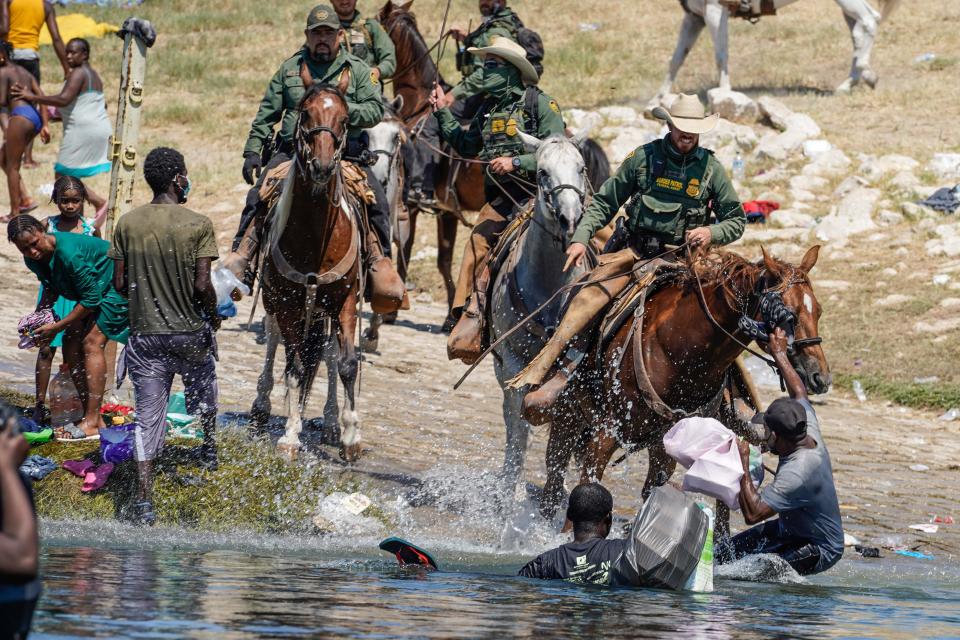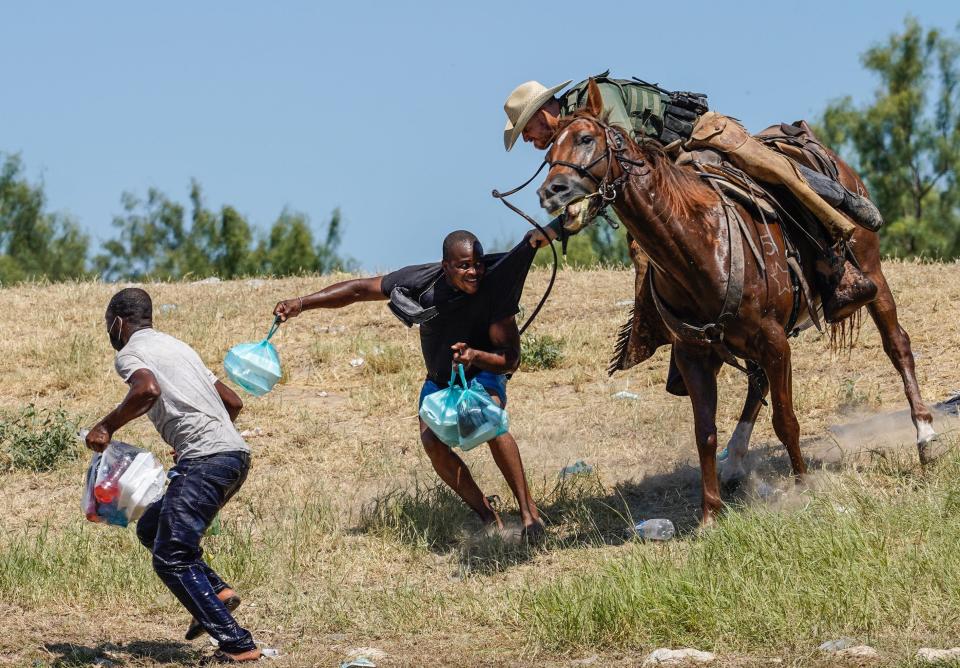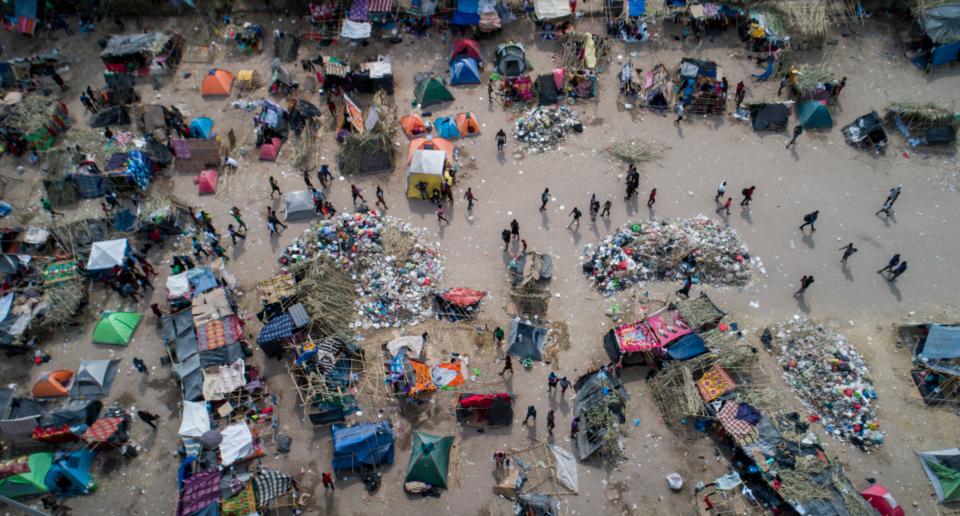'Appalled': Border Patrol agents' treatment of Haitian migrants criticized by former officials
- Oops!Something went wrong.Please try again later.
- Oops!Something went wrong.Please try again later.
The Border Patrol agent leans far out in his saddle, grabbing at the T-shirt of the barefooted Haitian man while a strap or rein whirls in the air.
Around them, other mounted agents use their horses to herd other Haitian refugees back into the waist-deep water of the Rio Grande, trying to stop them from crossing the border from Mexico into Texas. One falls back into the water. Others sprint away as the steel-shoed horses lunge toward them, agents waving leather straps.
Some of the migrants appear to be children. None appear to have more than food in their hands.
"Horrible," Vice President Kamala Harris said.
"Obviously horrific," said White House press secretary Jen Psaki.
"Troubled me profoundly," Department of Homeland Security Secretary Alejandro Mayorkas said.
Congress: Lawmakers decry images of Haitian migrants being chased by CBP agents on horses

The agents' aggressive treatment of the Haitian migrants near Del Rio, Texas, continued to draw criticism Tuesday after images of the encounter brought more attention to the migrants seeking refuge at the southern border. Officials promised investigations by both the White House and the Customs and Border Patrol's Office of Professional Responsibility, along with the DHS Inspector General.
Experts and former officials who spoke with USA TODAY say the treatment of the migrants raises questions about whether agents violated best-practices and training policies or whether violent treatment of peaceful migrants is simply common practice.
Jenn Budd, a former senior border patrol agent and an ambassador for the Southern Border Communities Coalition, said many agents see migrants and refugees as "liars, criminal and invaders," and treat them accordingly.
“What you saw those agents doing on horse was literally cattle-herding human beings," Budd said.
Haitians at the border: Criticized from all sides, Biden scrambles to address surge of Haitian migrants at southern border
Border Patrol policy permits agents to use "any available weapon, device, or technique in a manner that is reasonable and necessary for self-defense or the defense of another person," and that includes their horse.
“Obviously the Border Patrol is going to say that the agents feared for their safety. Or they'll say they feared for their lives,” Budd said. “And then that kind of allows them to use whatever they have at their disposal.”
At least 10,000 Haitian migrants have massed on the Texas border, and U.S. authorities say human traffickers have lied to the refugees about being allowed into the United States under President Joe Biden's presidency.

In May, citing the ongoing humanitarian crisis in Haiti, Biden extended special "temporary protected status" to Haitian refugees already living in the United States. While that status covers only Haitian migrants living in the United States as of May 21, experts say tens of thousands of Haitians have fled their home country following the July 7 assassination of President Jovenel Moïse and a devastating Aug. 14 earthquake that killed at least 2,200 people.
The migrants and the Biden administration's response has drawn widespread criticism from Republicans, including former President Donald Trump, who declared the United States is becoming a "cesspool of humanity."
The treatment of migrants at the southern border again cast a shadow on the government's treatment of refugees seeking a better life in the United States, with the images providing a new flashpoint.
"I was horrified to see the images," Mayorkas said Tuesday. "We do not tolerate any mistreatment or abuse of a migrant."
The border: White House calls video of border agents chasing Haitian migrants 'horrific,' DHS promises to investigate
Mayorkas said it appears the leather straps being swung may be horses' reins. Both DHS and CBP declined interview requests Tuesday, and instead provided written statements they had previously issued.

Experts consulted by USA TODAY say the mounted Border Patrol agents play a different role than most mounted police units, which are typically used to manage and control crowds. Because much of the rugged southern border lacks roads, agents on horseback have long been used to patrol, particularly at night.
Gil Kerlikowske, the former commissioner of U.S. Customs and Border Protection under President Barack Obama, said what happened appeared to result from a “very poor command decision.”
He added: “I don't think I've ever seen anything quite like the snippets of the video I saw yesterday. I don't think it was a particularly wise move.”
Theresa Cardinal Brown, an immigration expert and former DHS policy advisor under presidents George W. Bush and Obama said she was “appalled” at the footage.
“In terms of actually encountering migrants, I don't think that's appropriate in this day and age at all,” said Brown, who is now a managing director of immigration and cross-border policy at the Bipartisan Policy Center.
Brown said some Border Patrol agents who work in the field have long avoided accountability for their mistreatment of migrants. She said changing expectations of how refugees are treated should dictate new training and policies.
“One of the things that I would look at is what is Border Patrol training in these kinds of situations,” Brown said. “When is it appropriate to chase somebody? Why would you use any kind of force if you are chasing somebody? Is it appropriate to chase somebody on foot? On horse? All of those go back to the training and the policies that are in place.”
Vicki Gaubeca, the director of Southern Border Communities Coalition, said Border Patrol agents have a history of violence towards migrants, including a practice known as "dusting," when a Border Patrol helicopter hovers low over a group of migrants, deliberately blasting them with dirt and debris. Gaubeca said more than 120 people have died as a result of an encounter with a Customs and Border Protection agent since January 2010.
Del Rio migrant crisis: How did so many Haitians end up at the southern US border?
"In broad strokes, Border Patrol has a problem with its culture of cruelty towards migrants,” Gaubeca said. “It’s attitude towards migrants is that they are the enemy, and in doing so they dehumanize them.”
Speaking to reporters, Harris said she hopes the multiple internal investigations provide answers.
"What I saw depicted about those individuals on horseback treating human beings the way they were, was horrible," she said. "Human beings should never be treated that way. And I'm deeply troubled about it."
Budd, the former Border Patrol agent, said the images captured this weekend are shocking to most people but reflect common practice along the border. For some Americans, the treatment of the Black Haitian migrants evokes images of mounted patrols chasing down enslaved people before the Civil War, she said.
“I think what people are really seeing – and not just the fact of an American law enforcement officer riding after Black refugees and whipping them and the historical connotations of the gravity of that – but there's also the visual that most Americans don't see, that happens every day here on the border, where agents are taught to herd them like animals."
Jeff Self, a retired Border Patrol deputy sector chief who watched the news footage, said it's difficult to tell whether agents were trying to keep the migrants away from their horses to prevent injuries.
Self retired in July 2020 as deputy patrol chief agent of the Tucson Sector in Arizona after 33 years with the Border Patrol, including a stint with the Horse Patrol. He said agents assigned to the Horse Patrol are trained to prevent people from getting too close to their horses, to prevent them from grabbing the reins or the horse's harness.
Texas: US closes part of Texas border at Del Rio, begins flying Haitians home
"The critical piece of this if somebody gets close enough to control the horse's head by grabbing the reins or the harness on the horse's head, he now has control of the horse, and that can lead to serious injury or death to the agent or to the migrant," Self said. "Everything I see on this is appropriate."
Self said he believes it was appropriate for the Horse Patrol to be deployed in the operation to expel migrants who had crossed the river from Mexico and were camped out on the U.S. side of the border.
"Without a doubt. I think it's appropriate,' Self said. "This is an all-hands-on-deck situation here and you're going to utilize whatever you have available for the purposes of getting people from making illegal entry."
Robert Pusins, a police use-of-force expert, said mounted units are always aware of the risk that using horses poses to people. But he added that using mounted officers in rural areas can be different than in cities.
"You do have to be careful if you're using them for crowd control tactics because of the size and weight of the animal," said Pusins, the former executive director of the Broward County Sheriff's Office in Florida. "People naturally when they see a horse are going to back away, because of that size difference."
Pusins, who has seen pictures of the Del Rio incident but not video, said mounted patrols are also well aware that they're police officers dealing with people — not cowboys rounding up cattle.
"That's just common sense and reason, that you would have to consider that you're dealing with people and not livestock," he said. "Because people are not livestock."
Contributing: Kevin Johnson, USA TODAY, Daniel Gonzalez, Arizona Republic
This article originally appeared on USA TODAY: Border Patrol's treatment of Haitian migrants criticized by experts

